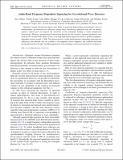Audio-Band Frequency-Dependent Squeezing for Gravitational-Wave Detectors
Author(s)
Isogai, Tomoki; Miller, John; Tse, Maggie; Barsotti, Lisa; Mavalvala, Nergis; Oelker, Eric Glenn; Evans, Matthew J; ... Show more Show less
DownloadPhysRevLett.116.041102.pdf (1.747Mb)
PUBLISHER_POLICY
Publisher Policy
Article is made available in accordance with the publisher's policy and may be subject to US copyright law. Please refer to the publisher's site for terms of use.
Terms of use
Metadata
Show full item recordAbstract
Quantum vacuum fluctuations impose strict limits on precision displacement measurements, those of interferometric gravitational-wave detectors among them. Introducing squeezed states into an interferometer’s readout port can improve the sensitivity of the instrument, leading to richer astrophysical observations. However, optomechanical interactions dictate that the vacuum’s squeezed quadrature must rotate by 90° around 50 Hz. Here we use a 2-m-long, high-finesse optical resonator to produce frequency-dependent rotation around 1.2 kHz. This demonstration of audio-band frequency-dependent squeezing uses technology and methods that are scalable to the required rotation frequency and validates previously developed theoretical models, heralding application of the technique in future gravitational-wave detectors.
Date issued
2016-01Department
Massachusetts Institute of Technology. Department of Physics; MIT Kavli Institute for Astrophysics and Space ResearchJournal
Physical Review Letters
Publisher
American Physical Society
Citation
Oelker, Eric, Tomoki Isogai, John Miller, Maggie Tse, Lisa Barsotti, Nergis Mavalvala, and Matthew Evans. "Audio-Band Frequency-Dependent Squeezing for Gravitational-Wave Detectors." Phys. Rev. Lett. 116, 041102 (January 2016). © 2016 American Physical Society
Version: Final published version
ISSN
0031-9007
1079-7114